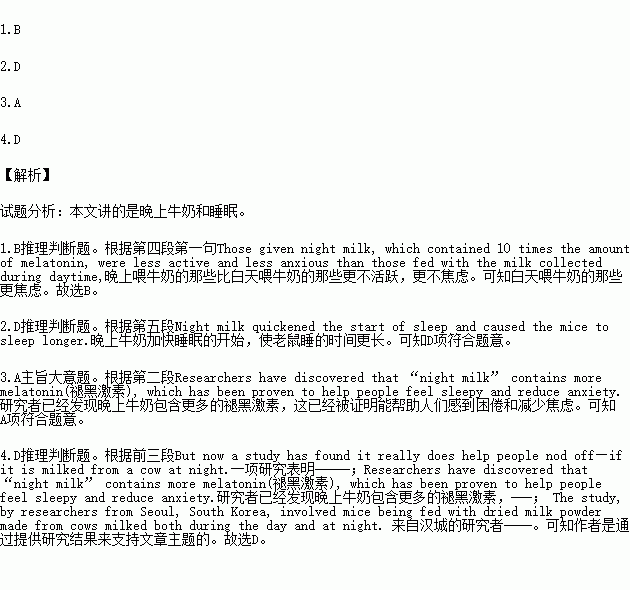题目内容
阅读下列短文,从每题所给的四个选项(A、B、C和D)中,选出最佳选项,并在答题卡上将该项涂黑。
A warm drink of milk before bed has long been the best choice for those wanting a good night’s sleep. But now a study has found it really does help people nod off—if it is milked from a cow at night.
Researchers have discovered that “night milk” contains more melatonin(褪黑激素), which has been proven to help people feel sleepy and reduce anxiety.
The study, by researchers from Seoul, South Korea, involved mice being fed with dried milk powder made from cows milked both during the day and at night.
Those given night milk, which contained 10 times the amount of melatonin, were less active and less anxious than those fed with the milk collected during daytime, according to the study published in The Journal of Medicinal Food.
Night milk quickened the start of sleep and caused the mice to sleep longer.
While the effect of cows milk harvested at different time has not been tested on humans up to now, taking melatonin drugs has been suggested to those who are struggling to fall asleep at night.
Previous studies have also indicated that milk can be excellent for helping sleep because of the calcium content, which helps people to relax.
Milk is also sugar-free and additive-free with nutritionists recommending skimmed milk as the best choice before bed as it is the least fattening. The more fat you take in before bedtime, the greater burden you will put on your body at night.
1.According to the text, the mice fed with daytime milk_______.
A. started sleep more easily
B. were more anxious
C. were less active
D. woke up later
2.Which of the following is true of melatonin according to the text?
A. It’s been tested on mice for ten years
B. It can make people more energetic
C. It exists in milk in great amount
D. It’s used in sleeping drugs
3. What can be a suitable title for the text?
A. Night Milk and Sleep
B. Fat Sugar and Health
C. An Experiment on Mice
D. Milk Drinking and Health
4.How does the author support the theme of the text?
A. By giving examples.
B. By stating arguments.
C. By explaining statistical data.
D. By providing research results.
 暑假接力赛新疆青少年出版社系列答案
暑假接力赛新疆青少年出版社系列答案
